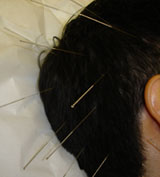|
☺Acupuncture Houston TX - West Holcombe Clinic |
☺Acupuncture Houston TX - South Shepherd Clinic |
 |
Houston Acupuncture and Herb Clinic at 2431 West Holcombe, Houston,
TX. @ the
corner of Kirby
Drive and next to the Flower Corner.
713-666-5667 |
 |
Houston Acupuncture and Herb Clinic at South Shepherd Dr., Houston,
TX@ the
corner of Westheimer
Drive and next to the KFC. This location has been
servicing Houston for more than18 years. |
Click here for the West Holcombe Clinic location
map.
The clinic is located at the corner of
Kirby Drive and
next to the Flower Corner.
☺TEL:
713-666-5667. |
Click here for the
South Shepherd Clinic location map.
Acupuncture Houston TX-South
Shepherd Clinic
☺TEL: 713-529-8332.
|
Acupuncture help migraine/ headache/ stress/ anxiety/
tension headache/ sinus headache.
The
head is a very important place where all the six Yang meridians
directly connect and gather. The head is the sea of marrow. All
twelve regular meridians and eight extra meridians are connected
with head.
Migraine/ Headache in Chinese medicine can be obtained from the
three directions. First, the headache arises from an attack of
external pathogenic factors. Second, the headache is from an attack
arising from internal damage. Third, the headache is due to
non-external and non-internal factors.
Etiology and Pathogenesis
1. Migraine/ Headache mainly results from the external pathogenic
factors
Migraine/ Headache is attributed by six pathogenic factors
especially from the wind, cold, dampness, and heat. Among the six
pathogenic factors, wind is the most predominant pathogen.
Exopathogenic wind is frequently accompanied with cold, heat, and
dampness. They usually get together to form a different group of
evil Qi. They invade the meridians and their collaterals either
before or after the penetration. The combinations of pathogenic
factors traveling along inside the channels and their branches
disturb the clear Yang in the head. Finally the contaminated
meridians and collaterals are suffocated and this leads to the
headache. For example, when wind associated with cold invades the
head; wind-cold evil Qi obstructs the clear Yang and cause the
stagnation of the blood circulation, resulting in a headache. When
wind associated with heat invades the head, the form of Wind –Heat
moves upwards to the clear cavity. They consume the blood and
essence and result in the disturbance of Qi and blood, again
resulting in a headache. When wind associated with dampness invades
the head, they attack external skin and muscle and moves upwards
towards the clear cavity, resulting in obstruction of clear Yang,
again resulting in a headache.
2. Migraine/ Headache mainly resulting from internal pathogenic
factors
Brain is the sea of marrow. It is nourished by the essence and
blood from the five Zang and clear Qi from the six Fu. Therefore the
cause of headache from internal pathogenic factors commonly relates
to spleen, kidney, and liver. Excessive sexual activity and old age
leads to the weakness of kidney Yin. The water is not able to
nourish the wood. Because liver Yang becomes overactive and moves
upwards to disturb the clear cavity, the headache occurs. Or a
deficiency of the kidney Zang not producing enough bone marrow
essence, leading to the sea of marrow getting emptied. The brain
loses nourishment and a headache results.
Disharmony of emotion and stress also cause the unhappiness of the
liver and liver energy creating transformed fire due to Qi
stagnation. The transformed fire moves upwards and disturbs the
clear cavity, causing the headache.
A person has an improper diet or suffers from too much stress,
causing the spleen to impair the transportation and transformation
of spleen Qi. Turbid phlegm is then produced and obstructs the
middle Jiao, which result in the clear Yang failing to rise and
turbid Yin failing to move downwards. Headache then occurs.
Headache may also result from the deficiency of the source of growth
and transformation. This deficiency of Qi and blood causes the brain
channels to lose the nourishment and brings forth headache.
3. Migraine/ Headache mainly resulting from non-external and
non-internal pathogenic factors
Prolonged diseases impairing the collateral, traumatic injuries
impairing the brain, and stasis of Qi and blood causes the blockage
of brain meridians. Headache results.
Diagnosis
1. To determine the type of headache, the most common way is to
distinguish the involvement of the twenty Meridians at the head. If
the headache is located in the forehead and area of the
supra-orbital bone, it is attributed to the Yangming meridian; the
headache at both sides of the head specially in the temple area
pertains to Shaoyang meridian; the headache at the back of head and
the neck belongs to the Taiyang meridian; the headache at the vertex
relates to the Jieyin meridian.
2. To determine the nature of pain and
location. One has to find out whether the pain involves the whole
head or just a localized area.
3. To determine whether the type of headache is
from exopathogenic or internal pathogenic factors. The onset of
exopathogenic factors is rapid and acute but temporary. The onset of
internal pathogenic factors is slow and mild but lingering.
4. To determine the inducing factors of headache. The inducing
factors can be overstress, climate changes, overeating, and
insomnia.
Treatment according to different
syndromes:
Migraine/ Headache due to the attack of the
exopathogenic factors
1. Wind-cold syndrome
a. Main symptoms: the whole head is aching, more severe, pain
extending to the neck and back, a feeling of the head being wrapped
up.
b. Sub-symptoms: aversion to wind-cold, no thirst and taste.
c. Tongue: thin and white coating
d. Pulse: floating with tightness
e. Treatment method: expelling the wind and dispersing cold
f. Prescription: Chunxiong Chatiao San
2. Wind-Heat syndrome
a. Main symptoms: distending headache. In severe cases, the head
is like being cracked.
b. Sub-symptoms: fever with aversion to wind-cold, a dark reddish
face, thirst and preference to drinking liquids, constipation, and
dark yellowish urine.
c. Tongue: red at the tip and sides with thin yellowish coating.
d. Pulse: floating and rapid
e. Treatment method: expelling the wind and clearing the heat
f. Prescription: Xiong Zhi Shigao Tang
3. Wind-dampness syndrome
a. Main symptoms: headache with a tight sensation, like the head
being wrapped up in a towel.
b. Sub-symptoms: heavy sensation in the limbs and body, stuffiness
in the chest, indigestion, loose stools, and difficulty in emptying
the bladder.
c. Tongue: white and greasy coating, slight reddish tongue body.
d. Pulse: soft or slippery.
e. Treatment method: expelling the wind and dispersing dampness.
f. Prescription:
Qianghuo Shengshi Tang
Migraine/ Headache due to internal impairment
1. Migraine/ Headache due to hyperactivity of Liver-yang
a.. Main symptoms: distended or pulsating headache, more severe
at both sides.
b. Sub-symptoms: dizziness and blurred vision, feeling anxious and
irritable, red face and reddish eyes, bitter taste in the mouth and
pain at the hypochondrium region, insomnia and a lot of dreaming.
c. Tongue: red tongue with thin yellowish coating or little coating.
d. Pulse: slippery or slippery with minutes and rapid.
e. Treatment method: calming the liver to suppress the liver yang
f. Chinese herb treatment: Tianma Gouteng Tang
2. Migraine/ Headache due to deficiency of Qi
a. Main symptoms: dull and hanging headache that comes and goes.
Overwork will aggravate the headache.
b. Sub-symptoms: dizziness, fatigue and tiredness, shortness of
breath and unwillingness to talk, spontaneous sweating, gray and
whitish face.
c. Tongue: slightly red tongue with teeth impressions on the sides,
thin and white coating.
d. Pulse: minute and weak or large and feeble pulse.
e. Treatment method: Supplementing Qi and directing the Qi of clear
yang upward to the head.
f. Chinese herb treatment: ShenQihuzhong Tang
3. Migraine/ Headache due to deficiency of blood
a. Main symptoms: prolonged, dull lingering headache.
b. Sub-symptoms: dizziness, palpitation and anxiety, insomnia, and a
lot of dreaming.
c. Tongue: light color, with thin white coating.
d. Pulse: very minute and weak.
e. Treatment method: Nourishing Yin and replenishing blood.
f. Chinese herb treatment: Bazhen Tang
4. Migraine/ Headache due to deficiency of kidney

a. Main symptoms: hollow headache
b. Sub-symptoms: weakness in the lower back and knees, dizziness
and tinnitus, forgetfulness, nocturnal emissions, leukorrhea,
fatigue, palpitation and anxiety, insomnia, the four limbs fearing
cold when excessive deficiency of kidney Yang occurs. Night
sweating, disturbing heat spreading to the five Zang, heat due to
excessive deficiency of kidney Yin causes tidal red face.
c. Tongue: light color with slightly swollen tongue or red tongue,
thin white coating or little coating.
d. Pulse: deep, minute and weak pulse, or minute and rapid pulse.
e. Treatment method: Tonifying the kidney essence.
f. Chinese herb treatment: Dabuyuan Jian
5.
Migraine/ Headache due to turbid phlegm
a. Main symptoms: unclear headache with the head feeling very heavy,
like a ton of weight.
b. Sub-symptoms: stuffiness in the chest and epigastric area,
feeling of fullness and indigestion of the stomach, dizziness and
blurred vision, fatigue and weakness.
c. Tongue: slightly red with white and greasy coating.
d. Pulse: slippery
e. Treatment method: to dry the dampness to dissolve the phlegm, to
alleviate pain by counter the flow of upward going Qi.
f.. Chinese herb treatment: Banxia Baizhu Tianma Tang
6. Migraine/ Headache due to blood stasis
a. Main symptoms: severe headache or stabbing pain, fixed pain
and chronic headache.
b. Sub-symptoms: mild headache at daytime, heavier headache at
nighttime, a history of head trauma, or long history of headache.
c. Red or blood stasis along the side of tip, or congested vein
under the tongue, thin and white coating
d. Pulse: minute or alternating between minute and rough
e. Treatment method: promoting the blood circulation and removing
the blood stasis.
f. Chinese herb treatment: Tongqiao Huoxue Tang
Acupuncture treatment for migraine or
headache:
1. Body acupuncture:
- Du Meridian- Baihui ( Du 20)
Gallbladder Meridian of Foot –Shaoyang.- Xuanlu ( GB 5)
Spleen Meridian- Sanyinjiao ( SP 6)
Stomach Meridian- Zusanli ( ST 36)
Triple Burner Meridian- Guan-Chong ( SJ 1)
- Large Intestine Meridian- Hegu ( LI 4)
Kidney Meridian- Taixi ( KI 3)
Liver Meridian- Taichong ( LR 3)
Ashi points
2. Moxibustion treatment
* Du Meridian- Baihui ( DU 20)
* Stomach Meridian- Zusanli ( ST 36)
* Bladder Meridian- Pishu ( BL 20)
Moxibustion therapy once a day, 2 or 3 times a
week. Moxibustion treatment is suitable for the headache result from
deficiency of both blood and Qi..
3. Ear acupuncture treatment
* Occiput, forehead, brain, shenmen, subcortex.
Two or 3 three points each treatment for 30 minutes. Two ear
acupuncture treatment a week.
4. Electro-acupuncture treatment
The point selection is the same as body acupuncture. Choose 1 to
2 pairs of points each treatment for 20 to 30 minutes. 2 to 3 times
a week.
|

